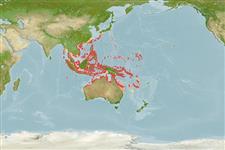>
Eupercaria/misc (Various families in series Eupercaria) >
Nemipteridae (Threadfin breams, Whiptail breams)
Etymology: Scolopsis: Name from the Greek masculine noun 'skolos' meaning 'thorn' and suffix '-opsis' (from Greek feminine n. 'opsis' meaning 'aspect', 'appearance') meaning ‘thorny appearance’ presumably referring to 'les dentelures de la préopercule, en ont aussi, et même d'épineuses, aux sous-orbitaires' mentioned by Cuvier (1814) in his designation of the genus. Name ending in -'opsis' are treated as feminine according to ICZN 1999: Article 30.1.2 (Ref. 130620).
More on authors: Quoy & Gaimard.
Environment: milieu / climate zone / depth range / distribution range
экология
морской ассоциированный с рифами; пределы глубины 1 - 20 m (Ref. 9785). Tropical; 33°N - 27°S, 93°E - 172°E (Ref. 3810)
Eastern Indian Ocean and Western Pacific: throughout the southeastern Indian Ocean, including Cocos-Keeling Islands and northwestern Australia, and from the Ryukyu Islands to the Marshall Islands and Vanuatu. Record from the Andaman Islands is unconfirmed. Referred to as Scolopsis cancellatus by most authors.
Size / Вес / Возраст
Maturity: Lm ? range ? - ? cm
Max length : 25.0 cm TL самец/пол неопределен; (Ref. 90102); common length : 13.0 cm SL самец/пол неопределен; (Ref. 3810)
колючие лучи спинного плавника (общее число) : 10; членистые (мягкие) лучи спинного плавника (общее число) : 9; колючие лучи анального плавника: 3; членистые (мягкие) лучи анального плавника: 7. Head scales reaching forward to or just in front of level of anterior margin of eye. Lower limb of preopercle naked. Antrorse (forward-directed) suborbital spine absent. Pelvic fins long, reaching beyond level of anus. Color: Upper body olive brown, silvery-white below. 3 yellowish white stripes along head and body. Juveniles white, with 3 black bands on upper half of body, interspace between lower pair of yellow bands; black spot between first three dorsal spines.
Common on coral reefs usually associated with sandy areas. Adults inhabit outer lagoon reef flats and seaward reefs flats, often in groups. Juveniles are found singly near the shelter of corals on clear shallow lagoon reefs (Ref. 9710). Adults form schools or small groups (Ref. 48635). Feeds on small fishes, crustaceans (Ref. 9710) and benthic invertebrates, primarily polychaetes (Ref. 37816).
Life cycle and mating behavior
Maturities | размножение | Spawnings | Egg(s) | Fecundities | личинки
Russell, B.C., 1990. FAO Species Catalogue. Vol. 12. Nemipterid fishes of the world. (Threadfin breams, whiptail breams, monocle breams, dwarf monocle breams, and coral breams). Family Nemipteridae. An annotated and illustrated catalogue of nemipterid species known to date. FAO Fish. Synop. 125(12):149p. Rome: FAO. (Ref. 3810)
Статус Красного Списка МСОП (Ref. 130435)
Угроза для людей
Harmless
Использование человеком
рыболовство: не имеет хозяйственного значения; аквариум: коммерческий
дополнительная информация
инструменты
Специальные отчеты
Скачать в формате XML
ресурсы в Интернет
Estimates based on models
Preferred temperature (Ref.
123201): 26 - 29.3, mean 28.7 °C (based on 1995 cells).
Phylogenetic diversity index (Ref.
82804): PD
50 = 0.5000 [Uniqueness, from 0.5 = low to 2.0 = high].
Bayesian length-weight: a=0.01622 (0.00956 - 0.02750), b=2.99 (2.85 - 3.13), in cm total length, based on LWR estimates for this species & Genus-body shape (Ref.
93245).
Trophic level (Ref.
69278): 3.8 ±0.59 se; based on food items.
Generation time: 0.8 ( na - na) years. Estimated as median ln(3)/K based on 1
growth studies.
устойчивость к внешним воздействиям (Ref.
120179): высокий, минимальное время удвоения популяции до 15 месяцев (K>1).
Fishing Vulnerability (Ref.
59153): Low vulnerability (15 of 100).
Nutrients (Ref.
124155): Calcium = 86.1 [49.8, 193.9] mg/100g; Iron = 0.9 [0.4, 2.2] mg/100g; Protein = 19.3 [17.4, 21.1] %; Omega3 = 0.148 [0.082, 0.264] g/100g; Selenium = 33.3 [17.3, 65.4] μg/100g; VitaminA = 44.9 [12.3, 147.8] μg/100g; Zinc = 1.41 [0.93, 2.14] mg/100g (wet weight);
